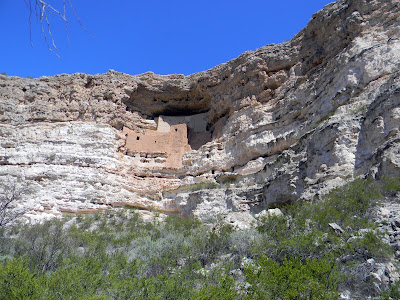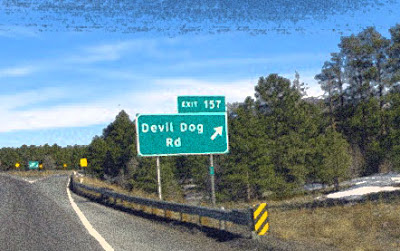Arizona Travels: Ancient Cliff Dwellings
Throughout
the state of Arizona, there are several ancient Native American ruins built in
the cliffs of the rocky mountains. They were constructed in the 12th
century and made of limestone, mud, or other various materials found in the region.
The cliffs offered protection from all the dangers surrounding the settlement. Many
of the dwellings are remarkable well preserved and worth a visit.
Tucked
in the mountains and just outside Sedona in the Verde Valley is the site where
cliff dwellers once lived. Since the building’s foundation resembled an Aztec
lodging, it was therefore given the name Montezuma Castle. The remarkable
structure was built by the southern Sinagua people in the 12th
century. Sinagua is Spanish for “without water”. They used limestone to build
their abode, which is a soft material causing varying breakage over a long
period of time. Because Montezuma Castle is wedged tightly inside the rock
cliffs, it has been protected by the elements and has remained intact for over
600 years. For that reason, this historic monument is one of the most
successfully preserved early ruins in the southwest.
The
five story dwelling with its 20 rooms is about 100 feet above Beaver Creek which
was used as their water source. It was speculated that they built the structure
high in the mountains because the spot offered protection from the desert
elements and their enemies. Below the cliff lodgings and along the base of the rock
face, sits Castle A. This structure was also constructed of limestone and is
almost completely gone from being worn down by time and the difficult Arizona weather.
The
Sinagua people were hunters, gatherers, and artisans. The area had an abundant
supply of deer, antelope, rabbit, bear, muskrat, and duck. They gathered many
of the local plants, vegetables, and cotton they grew using their skillfully
constructed canals for irrigation. They made their own stone tools, fashioned
rocks for grinding corn, wove clothes from cotton, and used the red rock
materials for their pottery. The red rocks were abundant in the surrounding
area.
The
Montezuma Castle Sinagua people lived in the high-rise rock apartments for over
400 years before vanishing mysteriously. By the early 1400’s, the cliff and
Castle A homes were vacated and left abandoned by the Sinagua. One speculation for
their unknown disappearance could be too many citizens living in the cramped
settlement, and not enough space to move around or sleep. Some believe it was the
severe weather changes causing the water to dry up which harmed their food
supply. Without the water, the animals would leave, in addition the surrounding
plants and all their crops would die. Another theory is that a plaque,
diseases, or too many fights ending in death may have caused the Sinagua
people’s extinction. Whatever the reason, they left us an outstanding place to
look at and wonder about.
When
the Montezuma Castle’s tours first began sometime in the 1930’s, people were
able to get a close up look at the structure tucked in the cliff. You walked
along a dirt path and climbed a succession of ladders up the side of the steep
mountain. When you arrived at the dwelling, you are able to step inside the
tiny room the Sinagua once lived in. In 1951, because of the deteriorating
limestone walls, tours no longer consisted of admittance to the ruins. Now we
have to admire it from afar.
Today,
you walk through the visitor center to gain access to the site. Inside the visitor
center you will find a museum, book store, and gift shop. After paying the fee,
you walk out a set of doors to a line of pottery once used by the Sinagua
people. A short distance to the right, up high and wedged into the mountain
side, you will observe the incredible ruins. It is amazing how well preserved
the structure looks. A short distance on the path is where you will see the
site for Castle A. Not much left standing of the edifice, just partial walls.
It is hard to imagine the structure as once being 6-stories high. Around the
corner is Beaver Creek where you will notice the picnic area amongst the many
trees. The last item on the path is a model of Montezuma castle without the
front walls. This tiny recreation gives us an idea of what it was like to live
in the high-rise rock apartments.
Montezuma Castle National Monument
P.O.
Box 219
Camp
Verde, AZ 86322
Phone:
(928) 567-3322
Website:
www.nps.gov/moca
Fees:
Adults (16 & over) - $5.00
Children (under 16) – Free
Hours:
Open daily from 8am – 5pm
Seven days a week (except
Christmas day)
Directions:
Follow I-17 to exit 289 (located 90 minutes north of Phoenix and 45 minutes
south of Flagstaff).
*Dogs
are allowed in the park but need to be on a leash no longer than 6 feet.
Tonto National Monument
There
are a couple of ways to find this monument from the city of Phoenix. You take
State Highway 60 (Superstition Freeway) east to Globe/Miami. From there you
will turn left and travel northwest on State Highway 188. It is approximately
25 miles from the turnoff till you arrive at Tonto National Monument.
The
other route is a bit rougher on your vehicle but will get you there much
quicker. From Phoenix, you will take State Highway 88 (Apache Trail) and travel
47 miles to your destination. Half of the highway is asphalt but the other half
is gravel. If you are planning to take the Upper Cliff Dwelling tour, this
route is not an option.
Despite
the fact they were constructed in the 13th to early 15th centuries, the cliff
dwellings are in remarkable condition. The people who occupied the Lower and
Upper rock habitats were farmers and hunters who feasted off the local animals
and vegetation. They created colorful pottery and wove complex patterns on
fabric which can be found around many places around the Southwest. You will
also be treated with a Visitor Center museum on the premises with many of their
items on display, models of the dwellings, and a history of the people who once
called this place home.
Hours:
Daily, 8:00 am to 5:00 pm except Christmas Day
*Lower
Cliff Dwelling trail closes to uphill travel at 4:00 pm.
Fees:
$3.00 per adult (good for 7 days); children under 16 are free
Walnut Canyon National Monument
The
rock apartments located in the cliffs 7.5 miles east of Flagstaff were built as
far back as the 1100s. Like many of the other Native American ancient sites,
the Sinagua people originally lived in these dwellings. In typical Sinagua
fashion, they mysteriously disappeared sometime in the middle 1200s, and left
their homes abandoned. The monument has been maintained by the U.S. National
Park Service and has a couple of trails which takes you to the ruins. The
Island Trail is a one mile paved trail to several dwellings where you can walk
through the tiny rooms. This trek will take you an hour to accomplish. The Rim
Trail is half the time and presents you with breathtaking views of the canyon
and an area to sit near the rim and enjoy the scenery. The ruins are merely
only part of what you will see when you visit the park. Walnut Canyon National
Monument has a picnic section, a visitor center with a bookstore and all kinds
of artifacts on display which were found during excavation of the ruins. Tours
are given all year long by Rangers who discuss the history of the ruins and
field trips are offered for groups of school children.
*The
location is around 7.5 miles east of Flagstaff.
From Flagstaff you will travel east on Interstate 40 and take the 204
exit and then head south. Another 3
miles and you will arrive at the Walnut Canyon Visitor Center.
Open:
All year (except Christmas Day), with extended hours from May to October.
Hours:
November to April – 9:00 am to 5:00 pm MST
May to October – 8:00 am to 5:00 pm
MST
Fees:
$5.00 (7 days); Free (children under 16)
Navajo National Monument
This
Anasazi cliff dwelling has two sizeable rock living spaces known as Betatakin
and Keet Seel. Maintained by the U.S. National Park Service and present you
with three self-guided rim trails (Sandal, Aspen and Canyon View) that offer
splendid views of the entire area. The Betatakin guided tour is free and is a 5
mile trek. On this 3 to 5 hour round trip excursion you will visit the 135 room
rock face apartments wedge deep in the cliffs. The Keet Seel jaunt takes you to
the 160 room dwelling and is a 4 to 6 hour trek each way. If you are interested
in taking this tour, you must make reservations ahead of time, limit your group
to 20 people, and have a permit to be in the area which you can purchase at the
visitor center. This tour is also limited to the months of May to early
September. The Navajo National Monument is open all year long and has longer
hours in the summertime. Both Sunset View and Canyon View campgrounds are open
all summer. Sunset View is also open in the winter and has water.
*The
location is at the end of State Highway 564 off of US Highway 160.
Phone:
(928) 672-2700
Hours:
Summer – May to September, open 8 am to 5:30 pm, everyday
Winter – September to May
(following year), open 9 am to 5 pm, everyday
Fees:
Call for information on guided tours. Free for all three of the self-guided
trails on mesa top. The campgrounds are free.
Canyon de Chelly National Monument
Just
about 210 miles northeast of Flagstaff sits another Anasazi cliff dwelling
ruins. These were also constructed from 1100s and 1300s. These sacred lands are
deep inside the Navajo Nation and maintained by the inhabitants. The Navajo people are willing to allow guest
to walk their lands, but not all places are accessible to the populace. Those
who want to take a self-guided tour of the area have three choices to make.
There are two paved picturesque roads to the south and north rims and a
magnificent view of the canyon. The other trek is 2.5 miles on the White House
Ruins Trail and slopes down 600 feet to the bottom of the canyon. If you are
interested in seeing more of the canyon, you need to acquire a permit and be
escorted by an official guide.
*The
location from Flagstaff – you take 1-40 east and then Highway 191 north. The
visitor center is 3 miles from route 191 in Chinle, AZ.
Phone:
Hours:
Open daily all year, 8 am to 5 pm, closed Christmas Day
Fee:
NO ENTRANCE FEE – No fee to drive around the park or hike the White House
Trail. (All donations are welcomed.)








Those dwellings are really something! I wonder what it was like living up that high? On the plus side, you would have had a great view. On the negative, you'd have to work to get up and down from your home!
ReplyDeleteI bet they were in great shape. I also read where the living quarters were tiny. Hopefully there weren't many family squabbles.
DeleteThat's beautiful. We have some cliff dwellings here in Colorado, and they make for a great day of sight-seeing. They won't let you climb up any of the ladders to get to the higher levels, though.
ReplyDelete